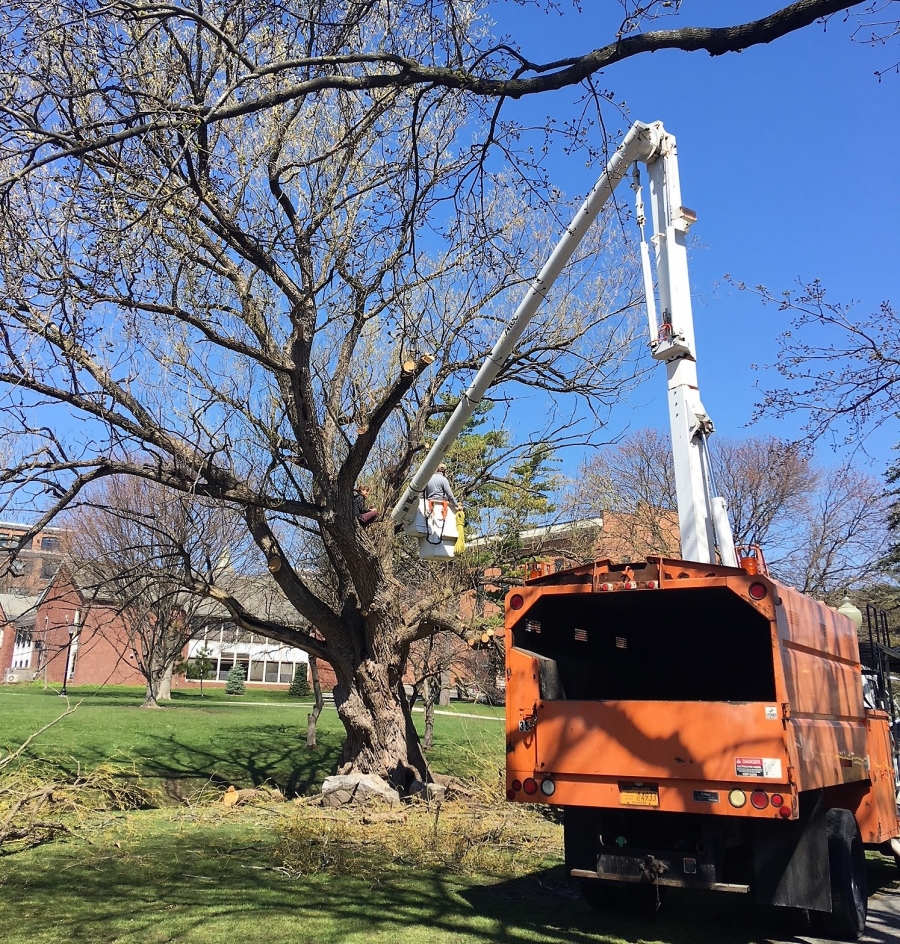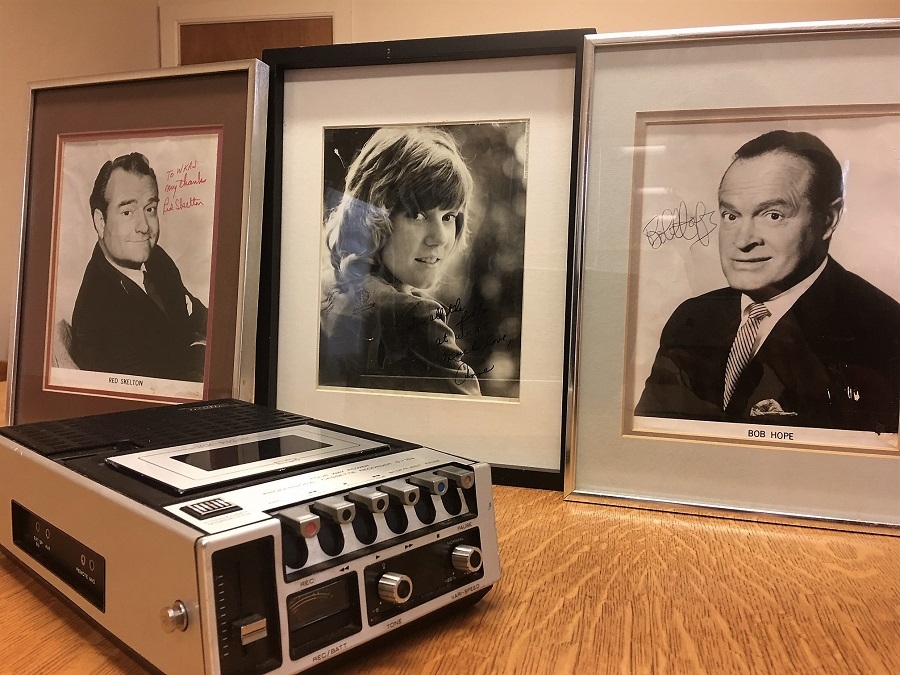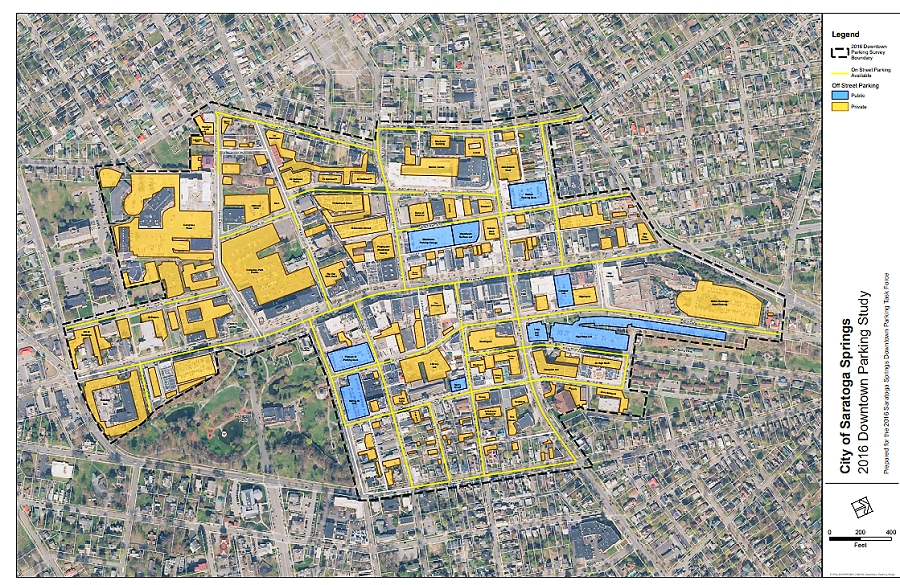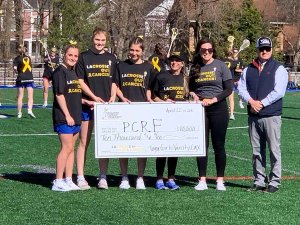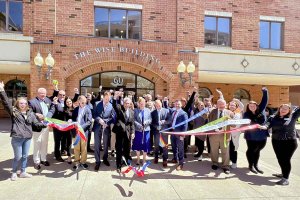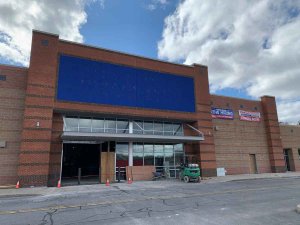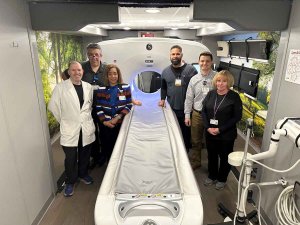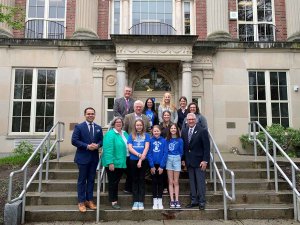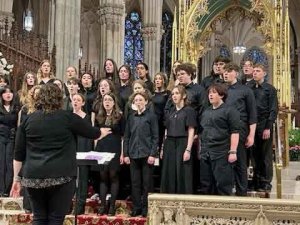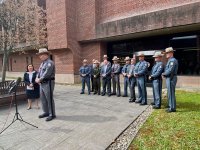Blood Drive Monday at City Center
SARATOGA SPRINGS - Every two seconds, someone in the U.S. needs blood.
A blood drive will be held 1- 6 p.m. Monday, May 7 at the Saratoga Springs City Center, room M1, at 522 Broadway.
An appointment may be scheduled online HERE, or by calling 1-800-RED-CROSS. Walk-ins are also welcome.
Who can donate blood? Standard “whole blood” donors must be at least 16 years old, weigh at least 110 pounds and be in good health and feeling well. More on eligibility requirements at redcrossblood.org.
Your blood donation will help patients of all ages, including accident and burn victims, heart surgery and organ transplant patients, and those battling cancer.
Woman Stages Tree Protest in Congress Park
SARATOGA SPRINGS - Rhianna Stallard was on her way to work Tuesday morning when she caught sight of some activity in Congress Park that prompted her to action.
“I was just driving by, when I saw them taking down this beautiful tree,” she said. “I pulled over and parked, then I ran in the park and went and jumped up, into the tree.” Two workers who were set to cut down the tree were forced to pause their actions as the woman sat high atop a limb of the tree, which is located a few yards from the Congress Park Carousel, for the better part of a half-hour.
“This tree is a staple of this park,” Stallard said. “Brides get their picture with it. Kids get their picture with it. I grew up with it.”
Prevented from cutting the tree, the workers were soon dispatched to another job, in another part of the city.
“The two workers were really nice, and we had a fine conversation,” Stallard said after the workers had gone and she descended from the tree limb. “They told me they’re going to wait, that they’re not going to cut it down today.”
The willow, which is marred by a two to three-foot wide hole in its trunk, will need to be removed for safety reasons, said DPW Commissioner Anthony “Skip” Scirocco.
“Nobody wants to see a healthy tree get cut down, but there’s nothing healthy about this tree. It’s either take it down, or it will come down by itself,” Scirocco said.
“We have talked about it for some time and we were hesitant. We asked if there was anything we could do to try and make it right, to try and save the tree - but there’s nothing,” Scirocco explained. “We talked about going in and trimming it a little bit, doing different things that might eliminate some of the issues, but in the end, it just kept getting worse and worse. I’ve got pictures from last year until now and the hole just keeps getting bigger.”
The commissioner said he has received complaints about park visitors’ safety from parents whose children play near the tree.
“Apparently some kid got inside of it,” Scirocco said. “We’re thinking: not good. The location is right by the carousel and it’s a dangerous situation. The tree is diseased and it’s in a public place where it could really create serious problems if it were to fall. And eventually it will fall, by itself.”
Scirocco said after the tree is removed, DPW workers will plant another one in its place.
NYRA receives approval to construct new Three-Story building at Saratoga Race Course
SARATOGA SPRINGS - The New York Racing Association, Inc. (NYRA) this week received approval from the New York State Franchise Oversight Board to proceed with construction of a permanent building at the site of the current At the Rail tent at Saratoga Race Course.
The project will replace the seasonal tent and trailers located immediately adjacent to the end of the Clubhouse with a 36,000-square foot, three-story, climate-controlled building featuring differentiated hospitality options and modern amenities. In addition to the three floors of usable space for guests, a basement level will provide space for a fully appointed kitchen to service the building.
NYRA currently plans to break ground on the project at the conclusion of the 2018 summer season and anticipates the new building will welcome guests on opening day of the 2019 meet.
“The new building will address the modern-day needs of Saratoga Race Course while honoring its history,” said NYRA CEO and President Chris Kay, in a statement. “We have taken great care to ensure that the building is historically consistent with the fabled architecture of our grandstand and clubhouse. We look forward to beginning the next steps of this much-anticipated project."
SOSH Architects will continue to oversee design, bid and construction administration services for the building. Matt Hurff, partner at Saratoga Springs-based Frost Hurff Architects, will continue to serve as project consultant to ensure all historic preservation standards are met.
The project has received the endorsement of the Saratoga Springs Preservation Foundation, which specifically noted the importance of the new building to the future of Saratoga Race Course.
In recent years, NYRA has placed significant resources behind historic preservation efforts at Saratoga Race Course. In 2015, NYRA began to restore the copper roofing that historically bordered the slate-covered roof on buildings throughout the property. This is visible in a number of locations, including the archway over the Clubhouse escalator, which was installed in 2016; the paddock mutuel building roof, to which copper accents were added in 2017; and the Clubhouse from the Easy Goer to the Club Terrace, which will feature the addition of copper along the roofline for the 2018 season.
In 2017, NYRA unveiled several upgrades to the historic paddock mutuel building, including a new slate roof and rafters. The improvements are intended to ensure the continued preservation of the historically-significant building, which was constructed in 1902 and originally used as a saddling shed during inclement weather.
The Saratoga Race Course Local Advisory Board also expressed support for the new building.
The new building is the latest in a series of capital improvements at Saratoga Race Course. Since 2013, NYRA has invested more than $30 million at Saratoga in efforts to enhance the guest experience and provide amenities that are consistent with those available at first-class stadiums and arenas.

These efforts are most recently demonstrated through the creation of The Stretch, Saratoga's newest hospitality area located in the grandstand at the Top of the Stretch, which will debut on opening day of the 2018 meet.
The Stretch will feature modern and upscale amenities in a casual environment with breathtaking views of thoroughbreds rounding the final turn as they enter the dramatic stretch drive. Highlights of the area include three types of boxes available in multiple configurations, a dining tier, reserved bar seats, and approximately 200 premium reserved seats.
Additionally, guests now enjoy more than 1,000 new high-definition televisions throughout Saratoga Race Course; 950 picnic tables available for free on a first-come, first-serve basis in the backyard; new high-definition video boards in the backyard and infield; enhanced Wi-Fi and sound systems; a renovated and redesigned Saratoga Family Zone; and new attractions and hospitality areas such as the Saratoga Walk of Fame, Fourstardave Sports Bar and Easy Goer.
The 40-day meet, which includes 69 stakes worth $18.8 million in purses, will run from Friday, July 20, through Labor Day, Monday, Sept.3.
Trash to Treasure
SARATOGA SPRINGS – Garage sales. Flea markets. Estate sales. Tony Izzo has rummaged through the past on a scavenger hunt to uncover history for as long as he can remember.
“I go to several of them a week and collecting things since I was a kid,” says the city resident, who works by day as a local attorney. “I especially enjoy collecting audio, and there is a lot of audio history out there - things that sat in someone’s attic or garage - but the problem is when people find this sort of stuff they can’t find anything to play it on, so they throw them out without knowing what they are.”
At one local sale he came upon a slew of boxes filled with audio tapes with no idea what they contained. “Nobody was paying much attention to them. I ended up buying five or six boxes and only paid a few dollars a box,” he recalls. “There were hundreds of tapes - 90 percent of them were re-recordings of commercial albums, but I learned there were also tapes from the estate of a man who was a local radio broadcaster and his collection had things he had accumulated throughout his career.”
The broadcaster was Herb Sabin of the radio station WKAJ AM 900, which was located on West Avenue in Saratoga Springs. Several hours’ worth of tapes revealed a local historical goldmine.
In the mid-1970s Saratoga Race Course hosted a series of 10-day events during consecutive summers in advance of the racing meet. The festival, called the Saratoga Fair, featured art exhibits and parades, firework shows, live animals, a children’s petting zoo, and nightly performances by some of the biggest entertainers of the day.
“The Saratoga Fair was a significant event in the 1970s for NYRA and for this city,” Izzo says. “I went to a number of them with my folks. For a few bucks you had access to the fair grounds and a major headline entertainer each night.”
A bandstand erected on the dirt track staged appearances by Johnny Cash and Glen Campbell, Bob Hope, Red Skelton, and The Smothers Brothers; Mickey Mantle, Willie Mays and O.J. Simpson came from the sports world to sign autographs. Each of the festivals drew more than a quarter of a million people over the 10-day gathering.
Sabin’s tapes feature the broadcaster’s rough-cut interviews with dozens of fair-goers, celebrities and local officials. George Bolster talks about his collection of historic Saratoga photographs, Tom McTygue speaks of the festival as being “a real boost for Saratoga,” Edward Villella, introduced by Sabin as “one of the most in-demand dancers in ballet,” is interviewed about the New York City Ballet’s summer season. Bob Hope talks about sustaining patriotism in the era of Watergate, cracks a few jokes about his stay at the Gideon Putnam hotel, and reminisces about his early days of struggle in Chicago during the 1920s.
“To me this is a very comprehensive and thorough audio history of this event that has not been very well documented. Just to hear the sounds of that event. I’m very pleased it’s preserved, instead of it just being thrown away in the trash,” Izzo says.
There are also interviews with singer Donna Fargo – who then had recently had a hit with the song "The Happiest Girl in the Whole USA," “Tonight” show bandleader Skitch Henderson, and excerpts from Red Skelton’s live stage show.
Bandleader Mercer Ellington charmingly talks about performing the songbook of his father, Duke Ellington: “mostly the standards, like ‘A Train,’ things that are easily identifiable – we’re not going to get far out and play any modern jazz or anything of that sort. We’re going to play the favorites for the people and the things they know him best for.”
The 1974 and 1975 festivals drew 254,000 and 293,000 people, respectively, and were co-sponsored by NYRA and Harry M. Stevens Inc. – who collectively invested about $1 million in the project each of the years. Joe Dalton, executive vice president of the Greater Saratoga Chamber of Commerce estimated the annual fair brought in to the local community about $3 million. But NYRA and the Stevens company bowed out after two years, citing a loss of $1.3 million. The 1976 fair was sponsored by a non-profit organization comprised of local residents and business owners. That season, too, resulted in a financial loss and in January 1977, the group announced the fair would be no more. Whether it was ultimately financial concerns, the trampled grounds of the race course in advance of the summer meet, or complaints from other area venues that ultimately doomed the fair isn’t clear, but after a three-year run it ceased after the Bicentennial Summer of 1976.

Other Voices, Other Rooms
Through his foraging, Izzo has uncovered a plethora of additional raw goodies on reel-to-reel and cassette tape. Whether they were publicly broadcast, or played once and disposed of, is not known. Among his collection are backstage interviews with Tommy and Jimmy Dorsey dating to 1956, and Johnny Mathis and Tony Bennett in 1960; Aaron Copland and Helen Hayes in conversation at Skidmore College; talks with Lloyd Bridges - accompanied by his pre-teen son Jeff Bridges, writers Joseph Heller and Frank Sullivan in Saratoga Springs, musician Count Basie in Glens Falls, and actress Jayne Mansfield who talks about her role in a production of “Nature’s Way” in the 1960s as well as how she is required to film two versions of her movies – one for open-minded European audiences, and one for the more conservative American market.
There is also a reel-to-reel tape Izzo possesses of a high-quality live Arlo Guthrie appearance in October 1975 at the Great Saratoga Music Hall, which stood at 106 Spring St. and has long since been converted to condominium apartments. The tape depicts stage announcements by Lena Spencer – the co-founder of Caffe Lena - introducing Guthrie and announcing upcoming concerts at the hall by Tom Paxton and Don McLean.
Guthrie meanwhile is heard joyfully interacting with the audience throughout his show and performing Bob Dylan’s “Don’t Think Twice It’s Alright,” Woody Guthrie’s “Talking Dust Bowl Blues,” “Do Re Mi,” and “This Land Is Your Land,” and a series of tunes carved from the great American songbook -“Swing Low, Sweet Chariot,” “Oh Mary Don't You Weep,” and “Goodnight Irene,” among them.
“Here’s what I learned,” Izzo says, “the lesson is if you come across something and don’t have the means to play it – think twice before throwing it away. It may be something significant. You just never know what you’re going to find.”
A partial list of entertainers performing at the Saratoga Fair.
1974 – Johnny Cash, Bob Hope, Red Skelton, Glen Campbell, Tony Orlando & Dawn, The Smothers Brothers, Mac Davis, Anne Murray, Willie Mays, O.J. Simpson. Admission: $2 adults, $1 kids. Parking: $1.
1975 – Olivia Newton John, Lynn Anderson, Mac Davis, B.J. Thomas, Red Skelton, Tanya Tucker, Roger Miller, the Mills Brothers, Bob Hope, Hudson Bros. Sports clinic, Q&A session with Mickey Mantle, Dave DeBusschere, Craig Morton, Ralph Kiner, Emerson Boozer. Admission: $3 adults, $1.50 kids. Parking: $1.
1976 – Johnny Cash, Fifth Dimension, Tanya Tucker, Donna Fargo, Anson Williams of Happy Days, Charlie Rich, Pat Boone Family. Tickets: $3.50 adults, $1.50 kids. Parking: $1.

Janet Jackson at SPAC July 26
SARATOGA SPRINGS - Janet Jackson brings her “State Of The World Tour” to the Spa City on July 26 when she stages a concert at Saratoga Performing Arts Center.
Tickets, which range from $29.95 - $179. 95 go on sale Friday morning online at LiveNation.com, Ticketmaster.com or Charge By Phone at 1-800-745-3000.
Changing Times, Changing Tactics
They crept down the hallway, two abreast, draped in their flak jackets and helmets and with weapons drawn.
A dispatcher’s voice crackled over the radio: “loading dock, amphitheater, for an individual armed with a handgun.”
City Police, State Police, State Park Police and members of the Saratoga County Sheriff’s Department gathered this week at the Saratoga Performing Arts Center to practice responding to terror scenarios involving an active shooter.
“It’s reality based and we try to do this as realistically as possible,” said State Park Police Lt. Donald Benware, as the officers took turns walking through the theater’s backstage area, confronting a “shooter,” and exchanging a volley of simulated rounds.
“We try to put the officers at a higher stress level (in the training). Let’s face it, we’re all human beings. Your blood pressure is going to go up. Get the adrenaline level up so they can feel that adrenaline rush and make sound decisions,” Benware said. “Also, it’s very important be able to come down off that. After an incident happens, they may be moved to another location and they need to be able to bring that heart rate down, bring their decision-making skills back into a more focused ability.”
One benefit of involving multiple agencies in the scenarios is that it builds a familiarity between law enforcement officials who don’t normally work alongside with one another. “Doing this type of training, we all get to see different faces and know different people and how they react in situations, so you have a little bit of a confidence, a little bit of an edge in a worse-case scenario if you have to respond to something like this,” Benware said.
Over the past 50 years, incidents have prompted law enforcement agencies to re-think their roles in response. In the 1960s, police departments began building special teams in reaction to terror-based incidents. The city of Los Angeles led the way with their Special Weapons and Tactics unit, or SWAT. But, the police response to active shooter incidents began to change following the Columbine High School massacre of 1999. Police showed up almost immediately after the shooting began, but waited for SWAT officers, who didn’t enter the school until much later. Police departments today focus more on stopping the shooter as quickly as possible, rather than waiting for SWAT teams to arrive, according to the 2014 report “Critical Issues In Policing Series,” published by Police Executive Research Forum.
Since that time, names like Columbine and Sandy Hook, Parkland and Virginia Tech became part of the sad map in American consciousness.
Last month, Saratoga County Sheriff Michael Zurlo announced he has a team of four deputies assigned to schools throughout the county who patrol during the day shift as well as the afternoon shift, and periodically conduct a school walk-thru to interact with students and school staff. While notable incidents have occurred in schools, some of the deadliest single day mass shootings in U.S. history have recently occurred where large gatherings of people come together: 49 people were killed and more than 50 injured inside an Orlando nightclub in 2016, and last October 58 people were killed and nearly 500 injured when a 64-year-old man opened fire on a crowd of 22,000 concertgoers in Las Vegas.
“We pull scenarios right out of the headlines,” explained Saratoga Springs Police Department Lt. Shane Crooks. “We look at different incidents that happen around the country and the world and we take those and fit them into a situation with the area that we have here. Any place you have a large gathering increases your risk of an attack. And this multi-force reality-based training here - we’re training where an incident could occur,” he said.
“The four agencies represented here today are the ones who will be here if something happens. By doing this type of training, we are preparing. We’ll have a better response, we’ll handle the situation better and keep everything safer,” Crooks said. “Every officer here is also learning the layout of SPAC, the grounds and the amphitheater itself, so if they do have to respond to a call, they’ll have that knowledge ahead of time.”
“This is in our jurisdiction. This is our home and our responsibility. That’s why we’re choosing this venue,” Benware added.
“We did have an incident back in the ‘70s in Saratoga Springs, at St. Peter’s. So, it can happen,” said Crooks, noting a December 1975 incident when a 32-year-old man recently discharged from the U.S. Navy aimed his .22-cal. handgun out his second-floor apartment window and fired four shots into St. Peter’s Elementary School playground. Two 7-year-old girls were injured.
“Every time something happens we re-evaluate our training, we change our tactics to prepare our officers to better respond to an incident,” Crooks said. “We want to respond as quickly as possible and we train the officers that we need to have a fast response to eliminate the threat.”
Rip Van Dam Hotel Revisions; Planning Board to Consider Code Blue Shelter Next Week
SARATOGA SPRINGS – Representatives of the Rip Van Dam hotel project provided a revised update of their plans to the Planning Board on April 5.
Among the revisions: the previously suggested orange brick face of the building has been changed to feature a softer white appearance; the proposed banquet facility will be replaced by a restaurant, and the newest configuration will total 159 rooms. Previous proposals varied between 142 and 176 rooms.
Parking will be via a multi-story garage with a 341-vehicle capacity to be built on Hamilton Street, just south of Congress Street, atop a current flat lot.
The Planning Board is slated to consider Shelters of Saratoga’s application(s) for a special use permit and site plan review for a proposed permanent Code Blue emergency homeless shelter on Walworth Street. It is anticipated the board may consider those applications at its next meeting, on Thursday, April 19.
This is the current lot, facing Hamilton Street, where a proposed multi-story garage will be constructed.
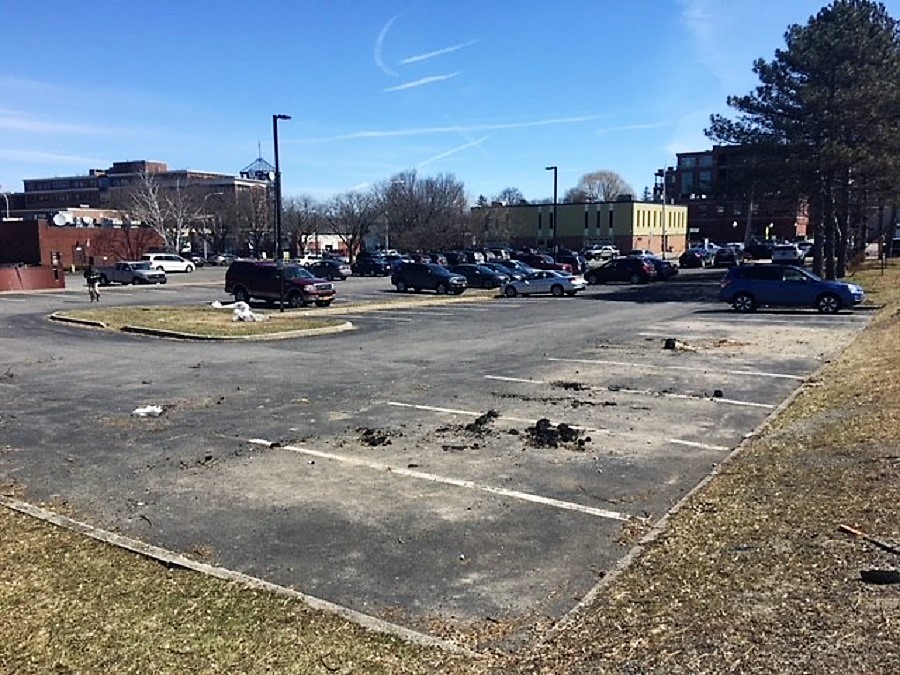
Upcoming Meetings
Monday, April 16: 9:30 a.m. City Council Pre-agenda Meeting.
Monday, April 16: 5 p.m. Planning Board Workshop.
Tuesday, April 17: 7 p.m. City Council Meeting
Wednesday, April 18: 7 p.m. Design Review Commission Meeting
Thursday, April 19: 6 p.m. Planning Board Meeting.
Local Restaurant Servers: Cuomo Wage Hike a Bad Tip
SARATOGA SPRINGS – A Gov. Cuomo directive to explore raising the wages of tipped food service workers to a flat rate is drawing the ire of many of the local workers for whom the idea was supposedly initiated to benefit.
“What the motives are I don’t know, but it’s apparently been presented to Cuomo like he’d be doing us a favor,” says Amanda Broderick, who has worked in the local restaurant industry for 16 years, the past nine at Olde Bryan Inn. “The servers aren’t asking for this (and) it would just devastate the local economy. They’re not doing us a favor.”
In upstate New York, the general hourly minimum wage is $10.40 per hour. Tipped food service employees make $7.50 per hour, before tips. When tips are added, many workers say they are capable of earning much more than the state minimum wage, based on the level of service they provide to customers. Besides wait staff earning more, this also enables restaurants working on slim profit margins to save the $2.90 difference per employee, per hour, as a “tip credit.”
The proposal to raise tipped food service workers to the general hourly minimum wage would eliminate that tip credit - forcing restaurants to pay more while assuming workers will earn less, and set into motion a decline in the labor force as well as restaurant service, and higher prices for dining consumers, the workers say.
“The best part of this industry is the relationships you build,” Broderick says. “And I do try to build those relationships because you get rewarded for the service you provide. I know the harder I work, the more money I can make.”
Broderick and her husband recently bought a house on the Great Sacandaga Lake. The daily commute to Saratoga Springs takes 45 minutes to one hour, but it is a trip that is worth it, she says, because the hours are flexible, the staff is passionate, and the money Broderick is able to earn helps pay the mortgage. One of the workers’ concerns is that if their basic wage is raised to the state minimum, tips would cease to exist.
“Right now, a lot of us make way more than the minimum wage. The tip credit helps restaurants pay a lower wage and keep prices down. What would happen is we’d end up making a lot less, menu prices would go up and eventually the mom and pops that Saratoga has so many of would have to close,” Broderick says. “If (Gov. Cuomo) is trying to find extra tax revenue, think of all the taxable income that would be lost in places like Saratoga. You don’t want to mess with a good thing.”
The Employee Policies Institute, a non-profit research organization that studies public policy issues surrounding employment growth, cites Census Bureau data that indicates tipped restaurant servers self-report earnings of more than $17 per hour on average statewide in New York, and suggests those estimates “are likely conservative.”
Susan Mezera has worked as a server for the past 43 years, from the former Lillian’s Restaurant to her current position at the Olde Bryan Inn. Working in the industry has helped her put her two children through college.
“When the public hears servers get minimum wage, people will have the perception that it won’t be necessary to tip,” Mezera explains. “People have mortgages and car payments. They’ve established their lives on the income they make, and that will drastically change. It’s already been practiced in other places and it didn’t work. Maine instituted this and a year later repealed it because it was such a disaster.”
In November 2016 a referendum to raise both the regular and tipped minimum wages in Maine won with 55 percent of the vote. Soon after, tipped servers began to complain that their earnings were being hurt as a result of customers tipping less. The measure was overturned in June 2017 in 110-37 vote by lawmakers.
Increased Costs for Restaurants
“For the restaurants, it would mean a large increase in labor costs. You’re looking at 30 servers and bus people in just one restaurant who are tipped employees - and restaurants are working on a small margin as it is. They may have to raise menu prices and put service charges on top of the bills to cover that. Servers would be let go and they’d probably do away with bussers and hostesses. The work would be spread real thin,” Mezera says. “With more tables to take care of, the quality of service will go downhill. If this happens and then at some later point they decide, ‘oh, this is not working,’ how many restaurants will have gone out of business? This is a busy town with the City Center, with it being a college town and there are a lot of restaurants. If half of them are gone, how many people will be laid off and out of work?”
A locally initiated online petition at change.org titled “Supporters of the Tip Credit in New York” has secured more than 7,000 signatures, and a collective group of business owners and employees urging Gov. Cuomo to preserve the Tip Credit have formed the Save Ny Tips Coalition, which hosts a web site and numerous social media pages with the hashtag: #savenytips.
“I think the group that’s really pushing it is a minority of people working in the restaurant industry who are Cuomo’s voter demographic in New York City. I think it’s purely political,” says Giuseppe Chiaravalle, who works at Wheatfields Restaurant.
“Look at it this way: when you go to a restaurant, you want to be wined and dined, you want good service. Going to a restaurant is an experience: the food, the ambience, the service. Servers know through their hard work, they can provide a superior experience to a customer and that they can get compensated for it with a tip,” Chiaravalle says. “I am willing to take less pay from the business knowing that through my hard work, I can actually make more and lift myself. I know I can work as hard as possible and see the results. Why would you take that incentive away?”
Workers say while they would earn a few dollars more in the raising of the minimum wage, the public would tip less, if at all. And without the incentive to earn tips, many would seek other opportunities in less challenging fields.
“On a track Saturday, where you’ve got five, six different tables and you’re running around the restaurant with 10 things in your head, why would you do all that if you’re only getting paid minimum wage, when you can make the same amount standing at a cash register,” Chiaravalle says. “The hardest working people will look to find a job that’s easier for the same pay. Service will go down because the best of the best are leaving and prices will go up. It’s not a situation where anyone wins.”
Higher Menu Prices
“It definitely would not be good for tourist places like this,” says Saratoga native Brayden Bosch, who has worked in the industry 11 years. “People come here for the track, but they also come for the nightlife-dinner side of it, and it wouldn’t be what they’re looking for anymore. The owners would have to pay a lot more, the workers who remained would be less enthusiastic and on top of that your food would cost more. So, people might not have to tip - but your $20 meal might cost $30 now. Before you could pay $25 with tip and everybody is happy.”
On the restaurant business side of things, the elimination of the tip credit would cost owners more money to meet the minimum wage gap, and those costs will continue to rise. The general hourly minimum wage in upstate New York is scheduled to increase to $11.10 at the end of this calendar year, up to $11.80 in December 2019, and to $12.50 one year after that.
“It would be disastrous,” says Nicci Miller, general manager at Wheatfields Restaurant, who began working in the industry 25 years ago as a busser at Lillian’s.
“You would have a whole group of working people who would lose everything. You have the restaurant owners who could potentially lose their business. Then you have the consumers who will lose every level of service they’re used to. All across the board, it’s a very bad idea,” Miller says.
“From a management perspective, raising wages by that much would be disastrous. In reality, it would stop being the hospitable town we are – which is part of Saratoga’s charm, that face-to-face interaction with people. There’s that communication as a server: where to stay, what to do, what to eat. You’re the visitor’s booth and you’ll lose all of that. It would change service in the entire state of New York,” she says.
And it’s not just the waiter or waitress you visibly see at the restaurant who would be affected, Miller explains. There is an entire support staff who depend on tips.
“You tip out the server 20 percent. From that, he tips 3 percent of that to the bar, because they’re making his cocktails, 2-1/2 percent to the busser who fills his water and clears his dishes, and another 1-1/2 to 2 percent to your food runner, who’s the person who brings the food to the table. It’s such a big circle, everybody takes a piece of it. And they all earn that money, they really do,” she says. “There’s a perception you have a restaurant owner that makes all this money, but in this business, you’re literally making pennies on the dollar.”
Gov. Cuomo previously raised the tipped workers’ minimum wage from $5 per hour to $7.50 in 2016. “We just took a 50 percent increase, and at $7.50 it’s one of the highest in the country,” says Tim Holmes, who with his wife Colleen owns and operates three restaurants in Saratoga Springs and four restaurants overall in Saratoga County.
“I ran the numbers on my company and if he was to pass this to go in effect in 2019 it’ll cost our company about $300,000. And that’s only the first jump before it goes up again,” Holmes says. With a slim profit margin, that amount would have to be made up potentially by reducing jobs and increasing prices. “But I’m not sure that we even can make all of that up,” Holmes says. “It’s a devastating number.”
Gov. Cuomo directed the Commissioner of Labor in December to schedule public hearings to examine industries and evaluate the possibility of ending minimum wage tip credits in New York State. The Department of Labor will be conducting those public hearings on Long Island on April 20, in Watertown April 25, Syracuse on April 30, Buffalo on May 7, and at the Legislative Office Building in Albany on May 18.
“Through the years you learn that your quality of service - how you take care of your customers – directly relates to the amount of money you can make,” Mezera says. “People go out to dinner for the experience: to be waited on, to interact with the server. You build up relationships through the years. They come in and ask for you. You’re able to share their special family moments, because you’ve established that amount of care with your customers. If they just wanted food they could go to a drive-through, or the places that have iPads on the table – which is what could happen if this goes through,” she says. “People are coming out and it’s our job to make them feel better, to have them enjoy their meal and to go out with a smile on their face.”
Correction: an earlier printed edition and online posting of this story contained a misspelled name of an interviewee. It has been corrected in this online edition.
“A Place All Saratogians Can Experience” - Grand City Venue Sets Sights on 2019
SARATOGA SPRINGS – A scatter of workers amble through the vintage chambers of Universal Preservation Hall, exploring the possibilities. Design plans sprawl across tabletops beneath stained-glass windows and free-standing easels boast colorful images of what will be. Soon, the heavy lifting will begin.
When the $8.7 million restoration of UPH is complete, in late 2019, the 19th century building will provide Saratoga Springs with something it has sorely been missing: a mid-range capacity venue with state-of-the-art sound, open year-round and expected to stage more than 200 events.
“It’s going to be a huge performance venue,” says Teddy Foster, whose association with UPH goes back more than a decade - from board member to president to its current campaign director.
“We’re going to be a huge music room, that’s how it’s being designed. We anticipate doing some Broadway cabaret and some live theater; we will be a place of collaboration for SPAC, for Caffe Lena, for people from the community, you name it,” Foster says, standing in the middle of a vacant 20-foot by 24-foot space on the main floor where the staging area for the 700-seat theater-in-the round venue will be constructed.
Tiered seating will be installed at the far end of the main hall – where the current stage sits – and at the opposite end, the balcony will be extended and fitted with seats that descend to the main floor. It will be handicap accessible with an elevator that navigates between floors, and a glass atrium will serve as the new entry way, off Washington Street, in “a super cool alleyway inviting people to come in,” Foster explains.
Event booking will be handled by Proctors, with whom UPH struck an alliance in 2012, and whose event management has included staging everything from major Broadway shows and cutting-edge film festivals to snagging pop music acts on national tours. Proctors’ stated mission: To be a catalyst - through arts and community leadership - for excellence in education, sustainable economic development and rich civic engagement to enhance the quality of life in the greater Capital Region.
Approximately 100 local jobs will be employed during the construction phase, which begins in earnest sometime between May and July. After the $8.7 million project is completed – expected to be in late 2019 - and the venue re-opens for business, it is anticipated UPH will bring approximately 65,000 visitors to the Spa City each year. “We will fill the hotel rooms and the restaurants during the off-the shoulder season,” Foster says. UPH also plans to hire six full-time employees and a number more on a part-time basis.
Earlier this week, Gov. Andrew Cuomo announced the venue will be awarded $750,000 to help redevelop the hall into a performing arts center. UPH represents Saratoga Springs’ sole recipient of the Restore New York Communities Initiative – which awards funding for projects that will reinvigorate downtowns and generate new economic opportunity in communities.
The Washington Street venue, which is a non-profit community performing arts center, is also entering into an energized public fundraising phase. The goal is to raise $5.5 million. “We’ve raised most of it,” Foster says. There is just under $1 million to go to reach that goal.
“I’m a huge music lover and I would love to see music of all kinds in that room,” says Foster. “You know this was built as a place where people could come together for all different kinds of things. That’s how we’ve kept it alive all these years. And that’s really what I want to have here: a place that all Saratogians can experience.“
City to Unveil Parking Management Bids Tuesday
SARATOGA SPRINGS - Bids received from the city’s request for proposals from potential parking management partners will be unsealed and publicly read 2 p.m. Tuesday at City Hall.
The city issued an RFP seeking the services of a professional parking consultant/management team to study, design and implement a Smart parking system in downtown Saratoga Springs. The stated goal, according to the proposal, is “to net the maximum financial benefit to the city balanced with downtown business vitality and efficient traffic management.”
Subsequent to selecting a winning bidder, the city is anticipated to host an organizational kick-off meeting on May 8.
The city currently owns and manages eight lots with approximately 1,288 “off-street” parking spaces, according to the Parking Task Force parking space inventory. There are an additional 1,302 public “on-street” parking spaces.
City owned and managed:
Public on-street parking: 1,302. Public off-street parking: 1,288 as follows:
- Woodlawn 3-level deck parking - 384
- Putnam St 2-level deck parking - 185
- Walton (Church St.) 2-level deck parking- 222
- High Rock upper & lower surface & Lake Ave. lot parking: 278
- Spring St surface lot parking - 98
- Henry St surface lot parking - 19
- Woodlawn surface lot parking – 60
- Collamer surface lot – 30
Additionally, non-city-owned and managed spots include: 83 spaces at the Saratoga Springs Public Library, and 2,552 spaces defined as “private off-street parking.”




 How to resolve AdBlock issue?
How to resolve AdBlock issue? 

